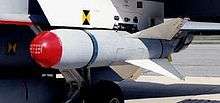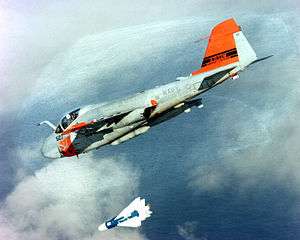AGM-62 Walleye
The AGM-62 Walleye is a television-guided glide bomb which was produced by Martin Marietta and used by the United States Armed Forces during the 1960s. Most had a 250 lb (113 kg) high-explosive warhead; some had a nuclear warhead. The designation of the Walleye as an "air-to-ground missile" is a misnomer, as it is an unpowered bomb with guidance avionics, similar to the more modern GBU-15. The Walleye was superseded by the AGM-65 Maverick.
| AGM-62 Walleye | |
|---|---|
 AGM-62 Walleye loaded onboard an aircraft. | |
| Type | Glide bomb |
| Place of origin | United States |
| Service history | |
| In service | 1960s–1990s |
| Used by | United States Armed Forces |
| Wars | Vietnam War Gulf War |
| Production history | |
| Manufacturer | Martin Marietta |
| Variants |
|
| Specifications | |
Launch platform |
|
History
The Walleye was the first of a family of precision-guided munitions designed to hit targets with minimal collateral damage. This "smart bomb" had no propulsion system, but it could be maneuvered via a television assisted guidance system during its glide from an aircraft to the target. As a pilot dived towards a target, a television camera in the nose of the bomb transmitted images to a monitor in the cockpit. Once the pilot acquired a sharp image of the target on his screen, he designated an aim point and released the bomb, which would continue flying toward the designated target on its own. The bomb was a true fire-and-forget system because once launched, the plane could immediately turn away from the aim point. The Walleye maneuvered itself using four large fins. Later versions employed an extended range data link that let pilots keep flying the weapon after its release, and even change aim points during flight (command guidance).
The idea of a TV guided bomb came out of discussions between an eclectic group of civilian engineers at the Naval Ordnance Test Center (later the Naval Weapons Center) at China Lake, California. One of the engineers, Norman Kay, built televisions in his home as a hobby. Kay built an iconoscope camera in 1958 that could do a "funny thing", recalled fellow project engineer William H. Woodworth. "It occurred to him that he could build a little circuit into there that would put a little blip in the picture, and he could make the little blip track things that would move in the picture". The two engineers, soon joined by Dave Livingston, Jack Crawford, George Lewis, Larry Brown, Steve Brugler, Bob (Sam) Cunningham and several others, decided to research the idea further and quickly secured some seed money from the Navy to advance the concept. Adopting some technology from the AIM-9 Sidewinder air-to-air missile project and developing other components from scratch, the group developed the bomb in just four years. Among other revolutionary breakthroughs, the group developed the world's first solid-state television camera with no vacuum tubes and the first zero-input-impedance amplifier.
The team worked at nights and on weekends to keep the project on track and convince the Navy of its worth. Woodworth was the electronics expert and went so far as to take a year off from work and attend graduate school at his own expense to gain some additional theoretical knowledge needed for the project. Woodworth and Steve Brugler breadboarded the original tracking circuitry. Brugler then did the detailed analysis and design of the tracker for initial production. Larry Brown worked tirelessly to analyze the bomb's flight traits, using an analog-computing instrument. Jack Crawford had an amazing "intuitive feel for physical phenomena", and could envision many of the flying traits of the bomb before it had even been built.[1]
First test and production contract
On 29 January 1963, a YA-4B Skyhawk flown by Cdr. J. A. Sickel, dropped the first Walleye at China Lake. The bomb scored a direct hit. Martin received the first production contract for the Walleye in 1966 and the bomb entered service with both the Navy and the U.S. Air Force the following year. The original Walleye I carried a 1,100-pound shaped charge and had a range of 16 nautical miles (30 km).[1]
In 1966, the AGM-62 designation was cancelled, the decision having been made not to designate guided bombs in the missile sequence; the AGM-62A was given the new designation Guided Weapon Mk 1 Mod 0, while its training version was Mk 2. Mk 3 was the Walleye ER, featuring extended wings to increase range, while the Mk 4 was also a training round.[2]
Use during Vietnam War
By May 1967, Navy pilots had dropped several bombs in Vietnam with great success. On 19 May 1967, Ho Chi Minh's 77th birthday, a Navy aircraft from the USS Bon Homme Richard scored a direct hit against the Hanoi power plant with a Walleye. The Navy hit the plant again with the bomb two days later, knocking out Hanoi's major source of power.
While softer targets such as power plants proved quite vulnerable to the Walleye, sturdier ones such as North Vietnam's well-constructed railroad bridges could not be downed even with a 1,100-pound weapon. Direct hits by the Walleye against the Thanh Hoa Bridge south of Hanoi in 1967 failed to take down even a single span of this notoriously strong structure.[1]
Walleye II, "Fat Albert"

To correct this major deficiency, China Lake developed a 2,000-pound version of the bomb, and deployed it to Vietnam in time for President Richard Nixon's Linebacker raids against Hanoi and Haiphong. The new Walleye II, or "Fat Albert" as it was nicknamed after the cartoon character, officially designated Guided Weapon Mk 5,[2] had an extended range data link and could hit targets up to 45 nautical miles (83 km) from its launch point. On 27 April 1972, a flight of eight Air Force fighters, two carrying 2000-pound laser-guided bombs and two carrying Walleye IIs, attacked the Thanh Hoa Bridge. Cloud cover prevented the LGBs from being used, but five of the Walleyes locked on, causing heavy damage to the bridge, even though failing to bring down a span. On 13 May, the Air Force finally brought down the bridge with 3,000 and 2,000-pound LGBs. The Vietnamese, however, soon repaired the bridge, compelling the Navy and Air Force to fly 13 more missions against the target. On one such mission on 23 October, four VA-82 and VA-86 A-7C Corsair II pilots from the carrier USS America took down the bridge with a combination of Walleye IIs and conventional 2000-pound bombs.[1]
Guided Weapon Mk 6 was a planned nuclear armed variant of the Walleye II. Designed to employ a modified W72 warhead with an estimated yield of around 600 tons of TNT, no known nuclear armed Guided Weapon Mk 6 Walleye IIs are thought to have been completed.[2]
Overall performance
While Walleyes accounted for less than six percent of the precision-guided munitions employed by the U.S. Armed Services during the Vietnam War, the weapons system could achieve excellent results under the right circumstances. The Navy often used the Walleye against the most important, hardest to kill targets. After the war, the Navy continued to employ upgraded versions of the Walleye through Operation Desert Storm;[1] shortly after the war the Walleye was retired, along with its main carrier aircraft, the Vought A-7 Corsair II.[2]
References
- Notes
- John Darrell Sherwood, Nixon's Trident: Naval Power in Southeast Asia, 1968–1972, (Washington: DC: Naval Historical Center, forthcoming).
- Parsch, Andreas (2002). "Martin Marietta AGM-62 Walleye". Directory of U.S. Military Rockets and Missiles. Designation-Systems. Retrieved 9 July 2014.
- Bibliography
- Bonds, Ray and David Miller. "AIM-9 Sidewinder". Illustrated Directory of Modern American Weapons. Zenith Imprint, 2002. ISBN 0-7603-1346-6.
External links
| Wikimedia Commons has media related to AGM-62 Walleye. |
- Designation Systems
- Globalsecurity.com detailed account of the Walleye bomb with photos and specifications